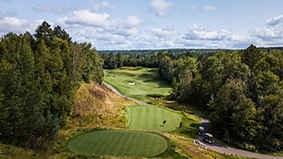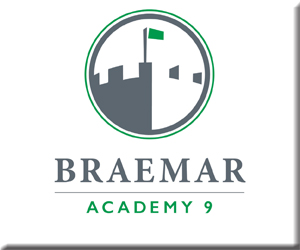Power Players – A “Golf Profile” Series
ARCHITECT: Jeffrey Brauer
By E. Nolan
It is PEOPLE that move the needle in golf, from the visionary developers who discover the land and hire the architects, to the creative course builders, the players from all walks of life fortunate enough to play their designs and the innovative gear gurus that equip everyone with the necessary tools for success. We all aspire to be Power Players in the game at some level. People like Jeffrey Brauer already are.
“Jeff Brauer belongs in the conversation on elite golf architects with legends of yesterday like Mike Strantz and the modern marvels of today like David Kidd.”
A long time architectural apprentice with many distinguished mentors but few opportunities for individual recognition, Jeff gambled on himself in 1984 and launched his own design firm in Dallas, Texas (still his home and work base today). We all hope someone will believe in us, to help kickstart our dreams, and Jeff found his initial backer in Shreveport, Louisiana – his big break a small 9-hole project. “Blessings come in ALL sizes.” The successful completion of that project opened the door for a TPC Las Vegas pitch. “And I thought for sure I had it,” Jeff says, “but ultimately didn’t get it. A high-profile project like that would’ve set my career on a very different track. Art Hills got a gig like that at the time and ended up developing half of Florida. That’s where I thought I was going.”
Nope. Not right away anyway. Instead of the bright lights of Vegas, Brauer ended up closer to the Northern Lights – a long, long, way from Florida and The Strip – in “Up North” country. “You had to settle for Minnesota?” I asked.
“Settle?” he shook his head emphatically. “Not at all! Sometimes the profile of a project is what you make it. Minnesota ended up being perfect for me. Three projects with good budgets, remarkable building sites and excellent owners that understood the input/output balance perfectly. They trusted me to execute everything as I said I would, and I’m confident everyone walked away satisfied.”
I’ll say. Those three projects he’s referencing are The Wilderness at Fortune Bay (#57 on Golf Digest’s “America’s 100 Greatest You Can Play” in 2018), The Legend (received 4.5 starts from Golf Digest from 1997-2005) and The Quarry (#30 on Golf Digest’s “America’s 100 Greatest You Can Play” in 2018) courses at Giants Ridge and an incredible $5 million renovation at Superior National (NEW Fall 2018).
Jeff’s first Minnesota project, the Legend at Giants Ridge, opened in 1997. The three-year project went through 26 routing schemes before construction and, while some do consider it their Giants favorite, Legend doesn’t receive nearly the appreciation of the Quarry. Brauer calls that the Pinehurst Factor. “Pinehurst has other noteworthy courses that would be highly ranked elsewhere,” he says, “but sitting next to #2… they’re vastly underappreciated.” Truth. That said, Legend’s 17th Hole was recently voted as one of America’s “101 Prettiest Holes” so, it’s not outright ignored. And the Quarry, while it is well deserving of all the accolades it receives today, it could have been a very different course. “We were offered several sites for that course, including one with 12 holes on Wynne Lake.” Twelve holes on the lake? “Yes,” Brauer nods. Wow. “Yes,” he nods again. “But, long story short, the quarry alternative was a huge success. We did site visits at Tobacco Road and World Woods and ultimately were told that we could build a similar course to those in Minnesota, as long as it was easier than Tobacco Road.” (He laughs.)
And then there’s The Wilderness at Fortune Bay, just 25 miles north of Giants Ridge – a course I contend is among America’s most underrated. Did that course turn out as he hoped? “Better,” he says, “believe it or not.” Oh, I believe it. The Wilderness is one of my Top 20 courses ever played. But then, I also realize that visions aren’t always realized as first imagined. Jeff had a story for that, too.
Mr. Brauer credits Alistair MacKenzie with a great deal of his design inspiration, particularly the dynamic green complexes and MacKenzie’s preference for “clean sweep” cape and bay bunkers over the more ragged sand traps trending today. “Interesting story… I ran into Allistair’s great nephew in Singapore who had letters stating that Mac didn’t like the design of Augusta National – didn’t like the plantation house being the clubhouse because it forced the routing up and down the hills instead of parallel with them.” Imagine what difference that might have made to the course… and to The Masters!
“I love golf architecture,” Jeff says. (Fresh off a 14-year run as a golf architecture columnist in Golf Course Industry Magazine.) “I’m always trying to learn more. I’m fascinated by every architect’s philosophy of building, I’m just not sure most know how to define what they do or why they do it. That’s why I loved MacKenzie. He knew exactly what he was doing and why he was doing it.” For instance? “Well… Mac liked to say that bunkers shouldn’t be used to punish, but to help create shot types.” Okay, I nodded.
What about Nicklaus? What can you learn from Jack Nicklaus about architecture? “I learn as much from what he says as what he does,” Jeff replies. “Jack mentioned that, when he has to hit a long iron, he likes to have a two-tiered green so he can land in the front with less spin and roll it up to the back. The way I figure… if Jack Nicklaus thinks that a good shot to play, that’s good enough for me!”
Jeff’s favorite golf courses in the world are Seminole, San Francisco Golf Club, Cypress Point, National Golf Links of America and pretty much any course designed by a couple more of his architectural inspirations, Charles B. Macdonald and Seth Raynor. He won’t concede a favorite of his own designs, but was willing to mention a favorite hole at each of his four Minnesota projects:
- #14 on the Legend at Giants Ridge: “I love the way the Christmas tree bunkering perfectly leads the eyes and shots to the green.”
- #6 on the Quarry at Giants Ridge: “The dramatic drop of a tee shot to a landing area we had to create, and that natural, ridge-defined approach.”
- #5 at The Wilderness: “The pinched landing area between the tallest trees leading to that superb Biarritz green.”
- #2 at Superior National: “Simple and elegant Par 3 over Minnesota’s most spectacular river.” (NOTE: There are six holes here that are truly spectacular! Somehow no golf magazine has figured that out yet and sent a photographer.)
What does the future hold for Mr. Brauer? “We’re opening a course called Tempest in Texas,” he says. “It’s an $8.8 million gut and rebuild of the worst designed course I’ve ever seen on the best property… if that makes sense. I’ve got an oceanfront project in Croatia in discussion and just completed a study on another fantastic 18-hole site in Minnesota.” (What? Tell me more!) So, he’s not exactly lacking in work. “No,” he laughs, “but I can always make room for more.”
In the event the Keisers, Mr. Morris, Mr. Thompson and/or any other phenomenal Midwest developers are listening, Jeff Brauer is a rare commodity – a home run hitter that doesn’t strike out – a highly-qualified, high-quality, candidate worth consideration on your next big project. Just putting the world on notice.

The Quarry at Giants Ridge







